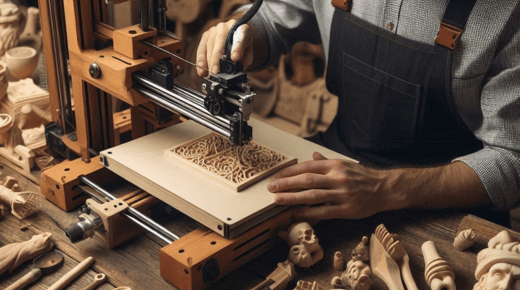Craftsmanship has always been about skill, precision, and a deep connection to the materials at hand. But in today’s fast-paced world, technology is transforming how artisans create and perfect their work.
From digital design tools to advanced manufacturing techniques, technology is not replacing traditional craftsmanship; it’s enhancing it. I’ve seen firsthand how modern tools can elevate the quality and efficiency of handcrafted goods.
Whether it’s a jeweler using 3D printing to prototype designs or a woodworker employing CNC machines for intricate cuts, technology allows artisans to push the boundaries of their creativity.
Similarly, handmade chef knives demonstrate how the fusion of traditional techniques and modern technology can produce exquisite results. This blend of old-world skill and new-world innovation is redefining what it means to be a craftsman in the 21st century.
The Evolution of Craftsmanship
Craftsmanship has a rich history shaped by centuries of tradition and innovation. In earlier eras, artisans relied solely on hand tools and manual techniques to create their works. Blacksmiths, for instance, used hammers and anvils to forge metal, while sculptors chiseled stone to achieve intricate designs. These methods were time-consuming and demanded a high level of skill and precision.
The Industrial Revolution marked a significant turning point by introducing machinery that could perform repetitive tasks more efficiently. This era saw the rise of mass production, but it also influenced individual artisans. Steam-powered machines enabled blacksmiths to work with metal faster, while mechanical looms revolutionized textile weaving. Though some feared these advancements would overshadow traditional crafts, many artisans adapted by integrating new tools into their practices.
In the 20th century, the advent of electricity and advanced machinery further transformed craftsmanship. Electrical tools like drills and saws offered greater precision and reduced labor time. Jewelry makers began using electric polishing machines, allowing them to achieve finer finishes. This period also introduced early forms of digital technology. Artisans embraced innovations such as laser cutters and computer-aided design (CAD) software, broadening their creative possibilities.
Entering the 21st century, digital technology now plays a crucial role in craftsmanship. Technologies such as 3D printing, CNC (Computer Numerical Control) machinery, and advanced CAD programs allow for unprecedented precision and customization. For example, jewelers can create complex pieces that would be nearly impossible to craft by hand alone. Similarly, woodworkers use CNC machines to execute intricate carvings and cuts with unmatched accuracy.
Today’s artisans blend traditional skills with modern technologies, maintaining the essence of craftsmanship while pushing its boundaries. This hybrid approach ensures that craftsmanship remains relevant and continues to evolve in response to technological advancements.
Modern Technologies Revolutionizing Craftsmanship
Today’s technology is transforming craftsmanship, offering artisans advanced tools to enhance creativity and precision.
Computer-Aided Design (CAD) Software
CAD software allows artisans to create detailed digital models of their projects. These models enable precise planning and visualization before any physical work starts. For instance, furniture makers can adjust dimensions and materials digitally, saving time and resources. CAD also integrates with other technologies like CNC machines, streamlining the fabrication process and ensuring accuracy.
3D Printing
3D printing brings unprecedented precision and customization to craftsmanship. Artisans can produce complex structures that would be impossible or time-consuming by hand. Custom jewelry, for example, benefits from 3D printing to achieve intricate designs and near-perfect symmetry. Small batches or unique, one-of-a-kind items are now more feasible and economical due to 3D printing.
Laser Cutting
Laser cutting technology provides artisans with the ability to cut and engrave materials with extreme precision. This tool is invaluable for detailed work in areas like woodworking, metalworking, and leather crafting. For example, fashion designers often use laser cutters for intricate fabric patterns. The technology minimizes waste by optimizing material usage and significantly reduces production times.
Benefits of Technology in Craftsmanship
Technology significantly enhances craftsmanship by improving precision, efficiency, and creativity. Artisans now integrate modern tools, allowing for remarkable advancements in their work.
Precision and Accuracy
Modern technology brings unparalleled precision to craftsmanship. Digital tools like CAD software enable exact designs down to the millimeter. 3D printing produces components with exceptional detail, essential for intricate work such as jewelry making. Laser cutting ensures clean, precise cuts, which is vital in woodworking and metalworking.
Efficiency and Productivity
Technology dramatically boosts efficiency and productivity. CNC machines automate complex tasks, drastically reducing manual labor. Automated tools cut production time, allowing artisans to complete projects faster. Advanced machinery processes materials more quickly than traditional methods, maintaining high-quality output.
Innovation and Creativity
Technology fosters innovation and creativity in craftsmanship. CAD software offers endless design possibilities, enabling unique creations. Artisans use 3D printing to prototype new ideas rapidly. Digital platforms provide access to a global market, inspiring new techniques and trends. Combining traditional skills with modern tools opens new creative avenues for today’s artisans.
Challenges and Concerns
Technology in craftsmanship presents several challenges that require careful consideration.
Cost of Implementation
Implementing new technology can be expensive. For small-scale artisans, the initial investment in tools like 3D printers or CAD software can be prohibitive. Operating costs also increase, as advanced machinery often requires regular maintenance and specialized training. Older equipment might not integrate smoothly with new systems, leading to additional expenses.
Loss of Traditional Skills
Relying heavily on technology may erode traditional skills. Craftsmen might focus more on mastering software than honing manual techniques, risking the loss of age-old craftsmanship. While technology facilitates efficiency and precision, it might replace the nuanced skills passed down through generations. Preserving these skills remains essential to maintaining cultural heritage.
Dependence on Technology
Craftsmen may become overly dependent on technology. When systems fail, work can grind to a halt, causing delays and financial losses. This dependency also raises concerns about the sustainability and resilience of the craftsmanship sector. Balancing technological use with traditional methods can help mitigate risks associated with overreliance.
Future Trends
Craftsmanship continues to evolve as new technological advancements emerge. These trends promise to revolutionize how artisans work and maintain traditions.
Integration of AI and Machine Learning
Artificial Intelligence (AI) and Machine Learning (ML) enhance craftsmanship by automating repetitive tasks. AI-powered tools, like design software, can generate patterns and suggest improvements. Artisans can focus on creative aspects while AI handles mundane tasks. Machine learning algorithms also offer predictive maintenance for tools, ensuring minimal downtime. Providing data-driven insights, these technologies optimize processes and reduce waste.
Virtual Reality and Augmented Reality
Virtual Reality (VR) and Augmented Reality (AR) transform how craftsmen visualize and execute projects. VR allows artisans to model designs in a virtual space, viewing them from different angles before actual production. This minimizes errors and material waste. AR provides real-time overlays on physical objects, guiding artisans during the crafting process. For example, AR glasses can show step-by-step assembly instructions, enhancing precision and efficiency.
Sustainable Practices
Technology aids in adopting sustainable practices in craftsmanship. Eco-friendly materials and processes become more accessible through digital platforms. 3D printing technology uses biodegradable materials, lowering environmental impact. Advanced software helps in optimizing material usage, reducing waste. These trends support artisans in maintaining high-quality craftsmanship while being environmentally responsible.
By leveraging these technological advancements, the craftsmanship sector can continue to innovate while preserving essential traditional skills.





